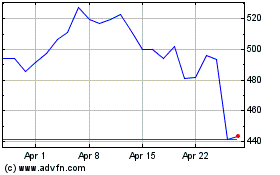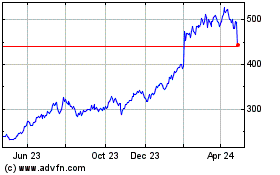By Katherine Bindley
While I was sitting with a group of ex-Instagram and Facebook
employees at their new office in San Mateo, Calif., talking about
their recently launched app, one of them, John Barnett, opened a
handwritten note that had been on the coffee table. It contained
well wishes from his former "fam" at Facebook. The card came with a
box of pins resembling the digital stickers people add to their
social-media posts: "Mood." "Squad." "Good vibes."
The good vibes are notable mostly because Mr. Barnett is now the
competition.
A former product manager at Instagram, he helped develop its
wildly popular stories tool, which had been pioneered by Snapchat.
Stories allow users to string together pictures and videos, enhance
them with text, stickers and visual effects and share them with
friends, usually for just 24 hours. Later, he went to Instagram's
big sibling, Facebook, and built a nearly identical stories tool
for it. Now he and two other former employees run Chroma Stories,
an app for -- you guessed it -- making stories. Users don't post to
the Chroma app, but they don't necessarily post on Instagram or
Facebook either.
"Right now we're focused on helping people create for whatever
platform they're on, if it's Facebook, Instagram, Snap, WhatsApp,
Pinterest, Twitter," says Mr. Barnett. "We just want to empower
their storytelling and give them I think more flexibility than what
the platforms give them."
One approach to trying to build the next big app for Gen Z is to
not build a social-media app. Instead, you build a social
media-adjacent one. It's too hard to pull them away from the ones
they're already on, so you meet them there -- on Instagram, YouTube
and Snapchat -- and you give them something that feels cool and
somehow distinct.
The Chroma app has various fonts, filters, layouts and
live-photo elements. There are over 150 different templates in the
free version of the app, some created with feedback from -- and
named after -- influencers with thousands or even millions of
Instagram followers. Some templates are Polaroid-themed, a vintage
look that's big among Gen Z right now. To make money, the company
charges $5 a month (or $30 a year) for a version with more bells
and whistles.
It's not the first app to try to catch the Instagram comet by
the tail. It's not even the first story-creation app -- Unfold and
others do the same -- it's just the latest. But it does have a trio
of founders who know the inner workings of the behemoths they need
to achieve success. They know as well as anyone the peril in
relying on them: The biggest players are regularly spotted copying
the most innovative features of upstarts, and occasionally even
buying those upstarts outright, only to squash them.
A Chroma comparison that comes to mind is VSCO. The
photo-editing app launched in 2012, designed as a tool for
photographers and artists to enhance their photos. Users soon began
sharing their work on Flickr, Tumblr and a newer app called
Instagram. In time, the #vsco and #vscocam hashtags were all over.
In 2013, the app's founders added a social feed and, later on, more
social networking, like the ability to republish someone else's
post and send direct messages. The app has no ads. There's a free
version and a $20-a-year premium version.
Today, nearly 40 million people use VSCO monthly, with 75% of
its user base under the age of 25. It's also -- possibly by
coincidence -- the label of a viral lifestyle trend: VSCO girls are
teens who've got a certain relaxed, not-trying-too-hard aesthetic
going on -- scrunchies, Birkenstocks and a beachy look are all key
components.
Vas Natarajan, a partner with Accel, a VSCO investor, says in
the early days, the company leveraged Instagram. "A lot of why we
got downloads was because people would see folks post photos to
Instagram but it would be hashtag VSCO," he says.
The trick, he says, is figuring out a way to get users back into
the product. In this case, it's VSCO's own smaller social feed.
VSCO doesn't display any popularity metrics, such as like and
follower counts, and calls itself a "safe space," free of the
judgment and comparison endemic on the major platforms.
"If you're an app developer, it makes sense if you can figure
out a way to make this work, to leverage the reach and the audience
of Instagram, Snapchat, TikTok," says Mr. Natarajan.
At Chroma, Mr. Barnett and his co-founders don't explicitly say
they aspire to do what VSCO has done -- they say they haven't paid
much attention to the app -- but there's notable overlap in the
language they use to talk about their own product.
"Our drive is not to, like, get people to share," Mr. Barnett
says. "We're really happy if you create and are happy with what you
created."
Nesrin Danan, 24, is a photographer who was already using
multiple tools outside of Instagram to create stories for her
120,000 followers.
"Instagram story tools are very primitive," she says. "I'm
pretty picky about how my stories look, so usually what I'll do is
take a photo or video or Boomerang and put it through VSCO, adjust
the lighting and the grain and all the filters and stuff."
Chroma flew her out to San Francisco, along with two other
influencers, to give feedback on the app. Eventually, they landed
on the idea of each having their own templates. She's been using
Chroma to make stories -- but still edits the actual photos in
VSCO.
Justine and Olivia Moore are 25-year-old identical twins and
investors at the early-stage venture firm CRV. They have a group of
175 Gen Z "scouts" who keep them posted on what's catching on. The
women say that if an app offers a tool that complements a behavior
Gen Z has already adopted -- and it's a tool they can't get already
-- it's got a good chance of going viral. It's an easier entry
point into the social-media market than trying to build a new
network from scratch.
"The incumbent platforms are so big and people already have,
like, broad audiences on those platforms. That is a heavy lift,"
says Justine Moore. "You'd have to get very lucky and have a very
unique product in some way to have a huge new social platform."
But the piggy-back approach still comes with plenty of risk: You
could flame out quickly if your user experience gets boring and you
don't keep updating your tools. ("Next week there's a new trend in
video," says Olivia Moore.) You've also got to avoid
over-dependence. Apps that require the social networks in order to
function have found their operations dismantled overnight when the
social networks cut off their access. Others have been copied or
acquired into oblivion. Twitter Inc. bought Vine, Facebook bought
TBH, and neither survived.
The ultimate example, of course, are those stories. Before they
were on Instagram, Facebook, and YouTube, "stories" were a key
feature of Snapchat.
As my colleagues revealed this past week, Snapchat parent
company Snap Inc. kept a "Project Voldemort" dossier to track
Facebook's aggressive tactics. "Businesses continually build and
iterate on concepts and ideas in the marketplace -- making them
better or taking them in different directions," a Facebook
spokeswoman told the Journal. "This is good for consumers."
That was part of Mr. Barnett's old job. The Instagram team he
was on would meet with creators to find out what features they were
using and what kinds of tools they'd ideally want. But Chroma's
founders say they aren't worried about Instagram copying them,
though they acknowledge it's a possibility.
"We've talked to a number of smaller social companies who
probably wouldn't want to be on the record about this who do feel
like once they release a feature, as soon as it starts getting
popular and they're like a tool of a platform, the platform can
just easily integrate it themselves," says Justine Moore. "If you
get big enough, they can just crush you."
"Keywords" columnist Christopher Mims is on book leave.
-- For more WSJ Technology analysis, reviews, advice and
headlines, sign up for our weekly newsletter.
(END) Dow Jones Newswires
September 28, 2019 00:14 ET (04:14 GMT)
Copyright (c) 2019 Dow Jones & Company, Inc.
Meta Platforms (NASDAQ:META)
Historical Stock Chart
From Mar 2024 to Apr 2024

Meta Platforms (NASDAQ:META)
Historical Stock Chart
From Apr 2023 to Apr 2024
